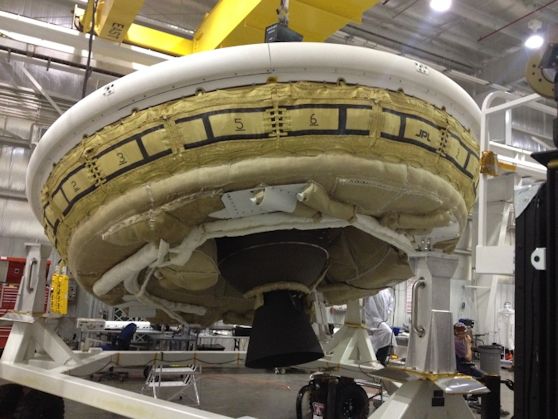
UPDATE:
Due to weather conditions, there will be no launch of the LDSD test vehicle today (June 3). Other potential launch dates include June 5, 7, 9, 11, and 14. Launch decision for Thursday, June 5 will be made on Wednesday, June 4. Check back here for updates, or follow this link.
ORIGINAL POST BELOW
Cool! On Tuesday (June 3, 2014), NASA will drop a flying-saucer-shaped vehicle from a helium balloon 120,000 feet (36,600 meters) above Earth, in preparation for future Mars missions. That’s happening today at 1:30 p.m. Central Standard Time in the U.S. (8:30 a.m. HST, or 18:30 UTC). That’s when the launch window opens at the U.S. Navy’s Pacific Missile Range Facility in Kauai, Hawaii. Officials are calling it an engineering shakeout flight.
The vehicle is called a Low Density Supersonic Decelerator (LDSD), and NASA TV will carry live images and commentary of LDSD engineering test. The test vehicle itself carries several onboard cameras. It is expected that video of selected portions of the test, including the rocket-powered ascent, will be downlinked during the commentary. Websites streaming live video of the test include https://www.nasa.gov/nasatv and https://www.ustream.tv/nasajpl2.
Michael Gazarik, associate administrator for Space Technology at NASA Headquarters in Washington, said:
The agency is moving forward and getting ready for Mars as part of NASA’s Evolvable Mars campaign.
He said that, as NASA plans increasingly ambitious robotic missions to Mars, laying the groundwork for human science expeditions to come, missions will require larger and heavier spacecraft. The objective of the LDSD project is to see if the cutting-edge, rocket-powered test vehicle operates as it was designed — in near-space at high Mach numbers. Mark Adler, project manager for the Low Density Supersonic Decelerator at NASA’s Jet Propulsion Laboratory, said:
We use a helium balloon — that, when fully inflated, would fit snugly into Pasadena’s Rose Bowl — to lift our vehicle to 120,000 feet. From there we drop it for about one and a half seconds. After that, it’s all about going higher and faster — and then it’s about putting on the brakes.
A fraction of a second after dropping from the balloon, and a few feet below it, four small rocket motors will fire to spin up and gyroscopically stabilize the saucer. A half second later, a Star 48B long-nozzle, solid-fueled rocket engine will kick in with 17,500 pounds of thrust, sending the test vehicle to the edge of the stratosphere. Ian Clark, principal investigator of the LDSD project at JPL, said:
Our goal is to get to an altitude and velocity which simulates the kind of environment one of our vehicles would encounter when it would fly in the Martian atmosphere. We top out at about 180,000 feet and Mach 4. Then, as we slow down to Mach 3.8, we deploy the first of two new atmospheric braking systems.

Can’t wait to see the pics from the test flight.
Read more about NASA’s first flying saucer test
Bottom line: On Tuesday, NASA had planned to drop a flying-saucer-shaped vehicle from a helium balloon 120,000 feet (36,600 meters) above Earth, in preparation for future Mars missions. But the flight test has been delayed.











